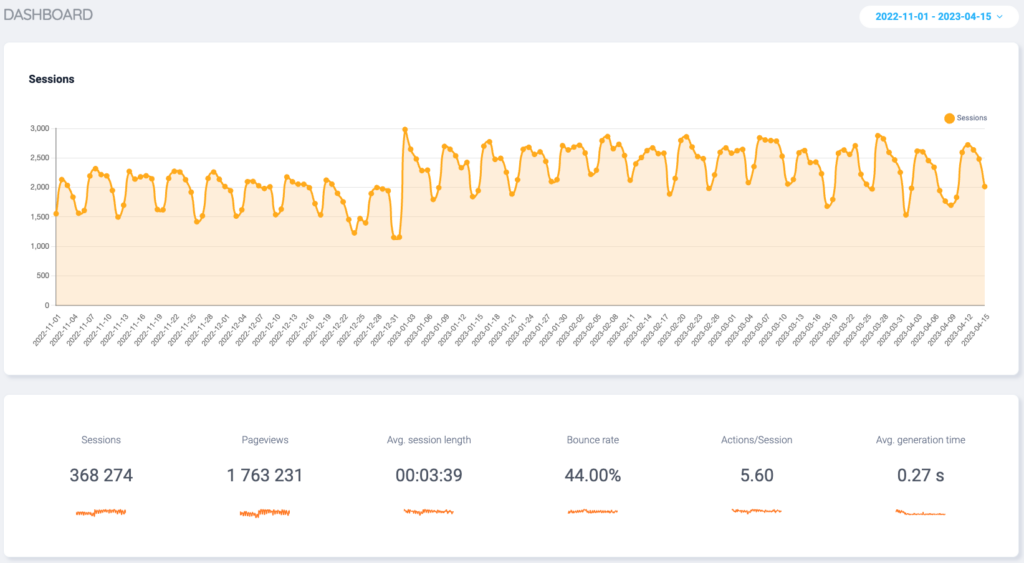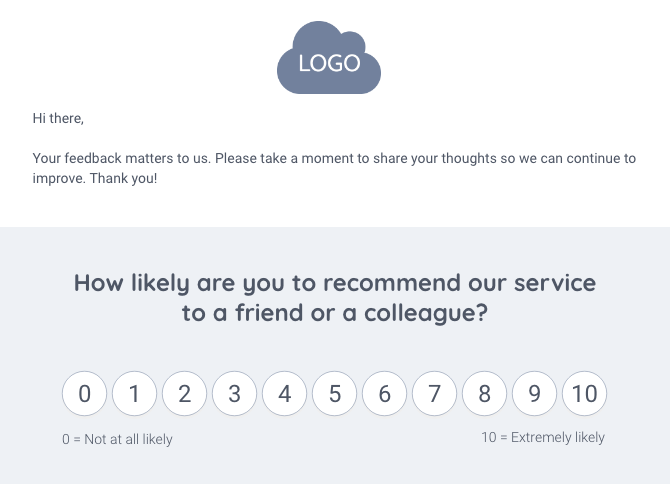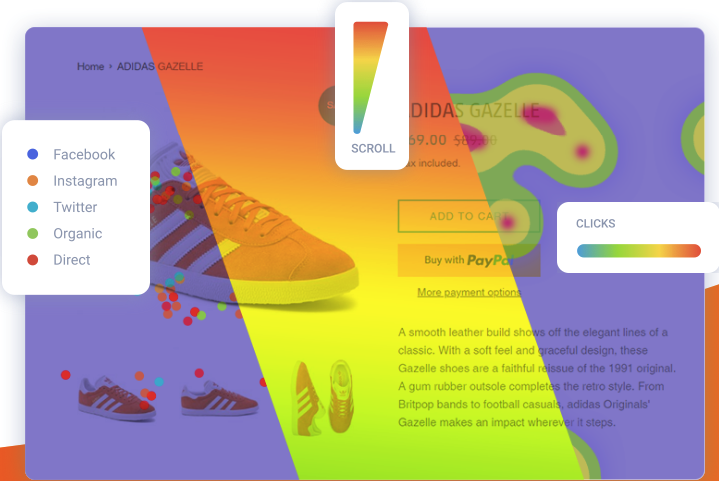Quantitative testing can be used to measure the usability of an interface. This method requires precise measuring instruments, and insights are derived from mathematical analysis.
Qualitative testing, on the other hand, focuses on the experiences, perceptions, and opinions of users. It’s more about how users feel about the product or service.
Together, these two testing methods can be used to test user experience and generate data for analysis. This, in turn, can lead to actionable intelligence which can result in improved time spent on-site by users.
Used together, quantitative and qualitative tests can also help to boost website traffic, Google SERP rankings, lead generation, and on-site conversions.
In the rest of this article, you will discover how you can use quantitative and qualitative tests for user experience in your own business. Let’s dive in!
Table of Contents
Quantitative Tests for User Experience
Before we dive into the process for utilizing these powerful tests, let’s start with the basics to ensure that we’re all on the same page.

What are Quantitative Tests?
Quantitative tests are all about objectivity and group behavior, and are more focused on answering questions such as “how many” or “how much“.
With this testing method, you can put a number on your product’s usability. It also makes it easier for you to compare different designs (for instance, your old version vs. the new one, or your competitor’s product vs. your own, etc.).
Furthermore, quantitative research helps you improve your next trade-off decisions and it even ties UX improvements back to your business goals and KPIs (key performance indicators).
This can be extremely helpful in demonstrating the ROI (return on investment) from all your UX optimization efforts.
However, it’s important to note that when using the quantitative user testing method, you can identify areas where things go wrong, but it won’t help you understand why that is.
You can use quantitative tests to test user experience as a way to understand how often a problem occurs, but if you’re going to understand the cause of the issue, you’ll need to implement qualitative tests (more on that later).
Examples of Quantitative Tests for User Experience
Techniques for quantitative testing vary widely and, depending on your needs (such as the type of data you want to collect), and other factors like the amount of effort and resources required.
You can choose from a wide range of UX research methods, and below I’ve listed some of the most commonly used quantitative user research methodologies, with a brief definition of each, and an overview of how the test is performed.
Note that although each of the methods outlined here will provide you with valuable quantitative data, they can also be adapted to fit different needs.
Analytics (for Websites, Apps, and Social Networks)

This type of test is used to detect or prioritize problems and monitor performance. The method is behavioral, which means that it has more to do with what people do.
It’s relatively low cost, and easy to do. However, there is a high degree of difficulty in the analysis of the collected data.
Website, apps, or social networks analytics will help you answer questions such as:
- What users are doing with your product
- Where they go and what they click on
- The features they use
- Where visitors come from
- The pages they view
- Where they are when they decide to leave your app or site
… and a wide range of other information that supports different UX activities.
In short, this testing method allows you to monitor the performance of your site, content, user interface (UI), product features, etc. so you can easily identify what works and what doesn’t.
This, in turn, will allow you to find ways to fix/improve your overall UX for better conversions.
When performing analytics on your website, also be sure to use rank tracking tools to see how your web pages are ranking on Google.
When creating a blog article or landing page, it’s best to optimize the content for search engines using a strategic keyword. You can then test how well the page performs for that keyword using rank tracking software.
This method of quantitative testing pairs well with analytics because it allows you to define strategic goals (e.g. ranking a page for a specific keyword) and then testing to see how the ranking of an article changes based on various analytics like bounce rate, traffic to the page, time spent on-page, and others.
A/B Testing vs. Multivariate Testing
Both A/B testing and multivariate testing are employed to compare design options in testing user experience, offering low-cost methods with minimal difficulty in data collection and analysis.
Although these methods assist in monitoring product performance, they serve distinct purposes in examining how various UI designs impact the associated metrics. A/B split testing focuses on comparing two different versions of a single element, while multivariate testing evaluates the interactions between multiple elements simultaneously.
To conduct A/B testing, you must create two distinct versions of the same page or UI, altering one or more elements (e.g., call-to-action button label, headline, or above-the-fold copy). Subsequently, present each version to different users to determine the best performer.
On the other hand, multivariate testing involves altering multiple elements within a single version to assess their combined effects.

This type of analytics-based experiment is excellent for deciding between different variations of the same design and can be useful for resolving disputes as to which version is the best and why.
System Usability Scale Survey
The System Usability Scale (SUS) is the most used tool for measuring a product’s usability. It consists of a questionnaire with 10 questions and 5 response options ranging from “Strongly Agree” to “Strongly Disagree”.
It’s a quick, affordable, and effective way to accurately evaluate the perception of usability of practically any kind of system.

Here are the 10 questions used in this survey, each of which can be adapted to suit your needs:
- I think that I would like to use this system frequently.
- I found the system unnecessarily complex.
- I thought the system was easy to use.
- I think that I would need the support of a technical person to use this system.
- I found the various functions in this system were well integrated.
- I thought there was too much inconsistency in this system.
- I would imagine that most people would learn to use this system very quickly.
- I found the system very cumbersome to use.
- I felt very confident using the system.
- I needed to learn a lot of things before I could get going with this system.
Net Promoter Score Survey
This type of survey is the gold standard of customer experience measurement. It’s designed to help you predict the likelihood of repurchase and referral.
The net promoter score measures the level of loyalty you might expect from your customer. It consists of two parts: A rating question and a follow-up, open-ended question.

The rating question asks customers to rate your product/service on a scale of 0 to 10. The follow-up question is to discover why the participant gave that specific score.
Quantitative Desirability Studies
Quantitative desirability studies are used to identify attributes associated with your brand or product.
This low-cost method of research is attitudinal, which means it’s focused on what people say. It attempts to quantify some quality of a product. This can be anything from aesthetic appeal to the tone of voice, brand strength, and so on.
This low-cost method of research is attitudinal, which means it’s focused on what people say. It attempts to quantify some quality of a product. This can be anything from aesthetic appeal to the tone of voice, brand strength, and so on.
You can customize the study via your research questions, but you must first expose participants to your product in some way (whether through actual use or by showing them still images).
Participants can then describe the product design by choosing appropriate options from a list of descriptive words.
If you have a large sample size that represents your target market, you will start to see trends emerging. For instance, you might find that 80% of your respondents describe the design as “modern” or “fresh“.
Quick Summary of Quantitative User Testing
- Question Answered by Quantitative Testing: How many and how much?
- Goals of Quantitative User Testing: Mostly summative – evaluate the ability of an existing product, track usability over time, compare with competitors, compute ROI, etc.
- Best Use of Quantitative Testing: When you have a working product, whether it’s at the beginning of the design cycle or at the end.
- The Outcome of Quantitative Testing: Statistically meaningful results with a high probability of replication in a different study.
- Quantitative Testing Methodology: Well-defined study with many participants and strictly controlled study conditions.
Qualitative Tests for User Experience
What are Qualitative Tests?
The objective here is to better understand why certain problems are occurring, which is why it’s crucial to focus on analyzing individual user experiences.
So as you can see, qualitative and quantitative tests are completely different user experience testing methods, and each has different goals.
The main objective in collecting qualitative data for user experience is to identify design features that are difficult or easy to use. The process is formative and summative, and you can inform design decisions and identify issues with usability in order to find effective solutions.
Examples of Qualitative Tests for User Experience
As with quantitative tests, there are many different types of qualitative UX tests that you can use.
Below, I’ve outlined some of the most common ones, together with an explanation of how the test works.
Interviews
This is where the researcher sits down with study participants on a one-on-one basis to discuss topics pertaining to specific products.
Interviews are a great way to learn about user perception of your design, but not its usability.

There are three types of interviews you can conduct, which are as follows:
1. Directed
Directed interviews are among the most commonly used methods for UX testing. They are typical question-and-answer interviews during which researchers ask specific questions. This type of test is particularly useful when dealing with large numbers of participants, or when you need to compare and contrast feedback from various users.
2. Non-directed
Non-directed interviews are those where a conversation is initiated between the user and researcher. So, instead of the question-and-answer format, the researcher establishes general guidelines for the discussion and then lets the survey participant do most of the talking.
3. Ethnographic
Ethnographic research looks at how users relate to tech in their native, real-world settings. This qualitative research study looks at the user’s social interaction in a given environment and provides in-depth insight into the user’s actions and views, together with the people, objects, experiences, sights, and sounds encountered during their daily activities.
Moderated User Testing
Moderated user testing involves the active participation of a moderator or a trained facilitator. These types of tests are typically held in a corporate setting or UX lab, but these days there are tools that allow you to conduct moderated usability testing remotely.
Let’s take a closer look at the two main categories of this type of UX research method.
1. In-Person
This test can be done when you need a high level of interaction between participants and moderators. For instance, you can use them when studying a prototype that has limited functionality, or if you need insights into a complicated concept or process.
This type of test allows you the interaction you need so you can guide participants through the study. It’s great for discovering pain points and understanding the customer journey.
2. Remote
Moderated user testing can also be conducted remotely through the use of testing tools and software.
This test works much like the traditional in-person usability test except that the user and the moderator are not in the same room. The moderator can observe the user using video conference software like Zoom.
Heat Mapping

A heatmap is a data visualization that uses a color-coding system to represent different values. Heatmaps are a powerful qualitative UX research method that you can use to discover user trends and help identify and troubleshoot issues with your product. For instance, you might use heat maps to understand how visitors navigate your site, or to see which areas of a page visitors linger on the longest.
If you’d like to know more about heatmap analytics, read our guide: https://capturly.com/guides/advanced-analytics-how-to-make-the-most-of-heatmaps/
Summary of Qualitative User Testing
- Questions Answered by Qualitative Testing: Why?
- Goals of Qualitative User Testing: Both summative and formative, including informed design decisions, identifying issues with usability, finding solutions for them, etc.
- Best Use of Qualitative Testing: This testing method can be used anytime, such as during the design, when you have a working product, etc.
- The outcome of Qualitative User Testing: Findings based on the researcher’s prior knowledge, impressions, and interpretations.
- Qualitative Testing Methodology: Few participants, flexible study conditions that are adjustable to meet the team’s needs, typically use the think-aloud protocol.
Using Quantitative and Qualitative Data Together
There are specific advantages to using each type of user testing method. For instance, one advantage of quantitative research over qualitative analysis is the statistical significance.
Quantitative data is protected against randomness, whereas qualitative research often falls prey to bias, which means the results are less objective than quantitative results, and therefore not a good representation of the entire target population.
But, the differences between these two analysis methods are what make them so powerful when used together.
Furthermore, quantitative data can be transformed into qualitative data and vice versa using specific testing methods.
Using qualitative and quantitative techniques together is sometimes called “mixed method” research, and many researchers agree that combining these two testing methods produces richer results and a more comprehensive understanding of the research topic.
It provides you with the “why” and the “what”, which will ultimately help you develop better products and connect more deeply with your users.
Right now, let’s take a look at the ways in which you can use qualitative and quantitative data together to get the results you need:
Use Quantitative Data to:
- Validate the hypothesis
- Understand the likelihood and frequency of a behavior
- Check (quantify) behaviors of large groups of people
- Determine the prevalence of people using your product in different ways
- Conduct confirmatory research
Use Qualitative Data to:
- Formulate a hypothesis
- Understand how and why a user behavior occurs
- Observe the behaviors of individuals or small groups of people
- Get feedback on the different uses of your product
- Conduct exploratory research
These are the many different ways you can add a quantitative component to your qualitative research (or vice versa).
As you can see, using these two methods in a complementary way will provide you with better insights so you can make more informed decisions for your business.
The Final Step: Announce the Results
After you’ve completed your quantitative and qualitative tests for improving user experience, you’ll have to compile the results in a way that is easy to understand. You’ll also have to categorize the data appropriately. Some should be shared only internally, such as private user information, while other data should be shared publicly to increase brand reputation, such as increases in your social media following or traffic to your website.
Once you’ve organized and categorized the data, now you have to announce the results to the right people in the right way. Internally, the information may be shared through business documents, memos, and other professional correspondence.
However, when announcing public results, you have to make sure you present your results in a way that’s engaging, interactive, and shareable. One of the best ways to do this is by hosting a webinar.
Not only can you earn passive income from the views on YouTube, but you can also cross-share the webinar in email newsletters, embed it on landing pages or within blog articles, and share it across all your social network accounts.
Just remember that it doesn’t have to be perfect. After all, perfect is the enemy of good. What you need to remember is that you’re not trying to create a cinematic classic or write the next great American novel.
All you need to do is get the information across in a way that makes your users hit the “Share” button. Anything more than that is overkill — and probably adding unnecessary costs to your marketing campaigns.
Conclusion
We have come to the end of this article on how to use quantitative and qualitative tests for user experience as an online entrepreneur.
Each of these methods has its own set of benefits and drawbacks, but when used together, they can help you understand the user experience on-site, as well as on specific pages of a website in order to improve UX, demonstrate your ROI, and achieve your business objectives.
Over to you. Do you think your business might benefit from using quantitative and qualitative tests together to improve user experience? Share your thoughts in the comments below!
Don't forget, sharing is caring! :)


2 Comments
Jason
2024-01-13 at 13:08Great Article. I want to mention the importance of offline surveying to test the UX of your website or app. We had done this for our client in an exhibition. We used to visit people and ask them to test the client’s website. We actually got great insights from them.
rice purity test
2024-02-05 at 04:47It effectively explains the importance of using both approaches to gather actionable intelligence and improve various aspects of a business, such as website traffic and on-site conversions. The examples of quantitative tests, such as analytics and A/B testing, offer valuable insights into how to measure and enhance user experience. Overall, this article serves as a useful guide for businesses looking to optimize their UX strategies.